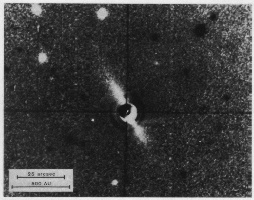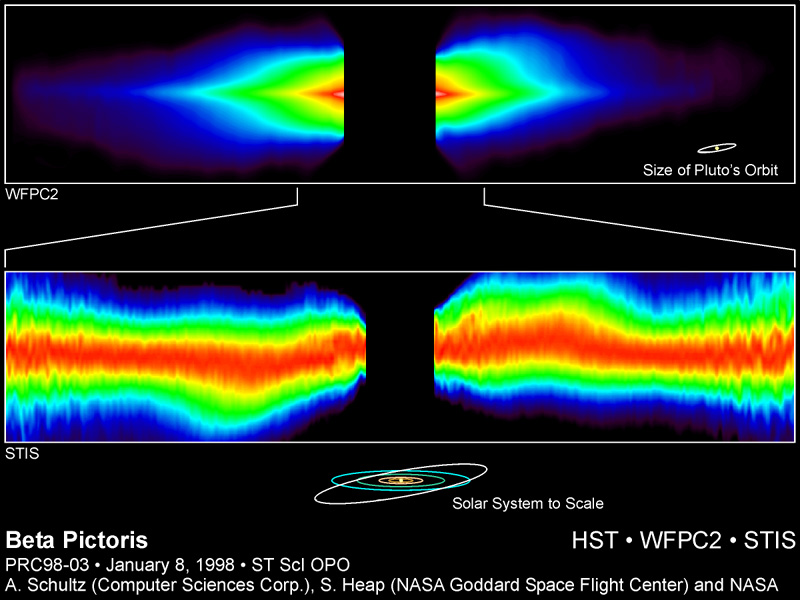2000 image (Kalas & Jewitt)
discovery image 1984 (Smith & Terrile)


Beta Pictoris at 0.5 micron
HD 39060 HR 2020 GJ 219.0
HIP 27321
RA (2000) = 05 47 17.1
Dec (2000) = -51 03 59.5
SpT = A5V V =
3.86 mag d = 19.3 pc
Proper motion (mas/yr) = +4.65 +81.96
Effective Temperature = 8200 K, Mass = 1.75 Msun, Luminosity = 8.7 Lsun
Absolute Magnitude = 2.42, Absolute Bolometric Magnitude = 2.43
Chemical abundances: X=0.70, Y=0.28, Z=0.02 (i.e. solar, X=H,Y=He,Z=heavy elements)
Age > 8 Myr
The bright star beta Pictoris is visible in the
Southern Hemisphere and has the brightest,
most extended dust disk of any nearby star.
Optical images (0.5 microns) show the disk because
dust reflects light from the central star and
towards the observer.
Data from the IRAS satellite in 1983 first revealed
that the star is emitting more thermal
radiation at far-infrared wavelengths than is
normal for this type of star. Brad Smith and
Rich Terrile then obtained an optical image of
what appears to be a needle-like reflection
nebulosity around the star (shown above).
This image was a cornerstone for the paradigm that
nearby stars which emit more far-infrared
radiation than can be explained by the star alone
are surrounded by circumstellar dust disks.
Many more images were subsequently obtained
by several research groups.
On the left (above) we show beta Pic observed
from Mauna Kea on 12 October, 1993, with University of
Hawaii 2.2 meter telescope. Light from the star
is blocked by a 6.5" diameter opaque spot inserted
at the focal plane of the telescope, revealing
the much fainter dust disk. A closer inspection of this
image reveals that the northeast extension is
not a mirror image of the southwest extension. The
northeast extension is brighter, longer, and
thinner than the southwest extension. Here we see
the northeast extension extending out to 48"
(790 AU) from the star, whereas the southwest extension
can be traced only out to 40" (650 AU).
A gravitational perturbation, such as from a planet or a passing
star, may be responsible for the asymmetries.
Below we show optical images of beta Pic obtained
more recently by the Hubble Space Telescope (HST).
Due to HST's excellent resolution, the images
revealed that the midplane of the disk is vertically warped
very close to the star, at radius 50 AU.

In summary, optical images of beta Pic
provide the following information:
1) Disk is big: greater than
1300 AU in radius.
2) Dust is depleted within 100 AU of the
star
3) Grains are large-sized (10 microns)
4) Morphology is asymmetric, possibly due
to gravitational perturbation
In addition, optical spectra have revealed possible
cometary activity near the star.
Basic facts about the beta Pic disk:
1) age is estimated to be between 10 Myr and 100 Myr
2) Some circumstellar hydrogen gas detected, optically thin dust disk
3) extended between 30 AU and 1300 AU radius, and possibly even farther
4) central dust depletion inward of 100 AU
5) mass in millimeter-sized grains is approximately equivalent to
a few Moons
6) silicate feature detected in the mid-infrared, matching that of
comet P/Halley
7) morphology is significantly asymmetric, possibly due to a planet
or other companion
8) spectra of star show variable and transient absorption features,
almost always redshifted,
thought to arise from families of comets crashing into the photosphere
every day.
9) optical color of disk is neutral, indicating that largish (10
micron) grains are dominant
10) disk is seen almost exacly edge-on from our point of view.
Burrows, C.J., Krist, J.E., Stapelfeldt,
K.R., et al. 1995, "HST observations of the Beta Pictoris circumstellar
disk", BAAS, vol. 27, pg. 1329
Heap, S.R., Lindler, D.J., Woodgate,
B. et al. 1997, Hubble/STIS Coronographic Imagery of beta Pictoris, BAAS,
vol 191, pg. 4702
Kalas, P. & Jewitt , D.
1995, "Asymmetries in the Beta Pictoris Dust Disk," Astronomical Journal,
vol. 110, pg. 794.
Smith B.A. & Terrile, R. J.,
1984, A circumstellar disk around Beta Pictoris, Science, vol. 226,
pg. 1421-1424.
Copyright, please do not reproduce
without permission from the authors.


